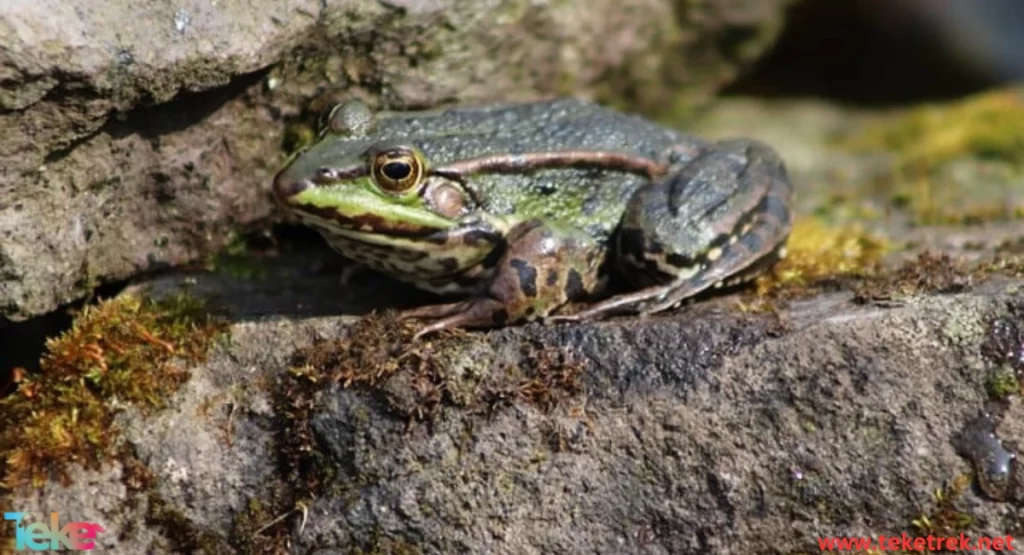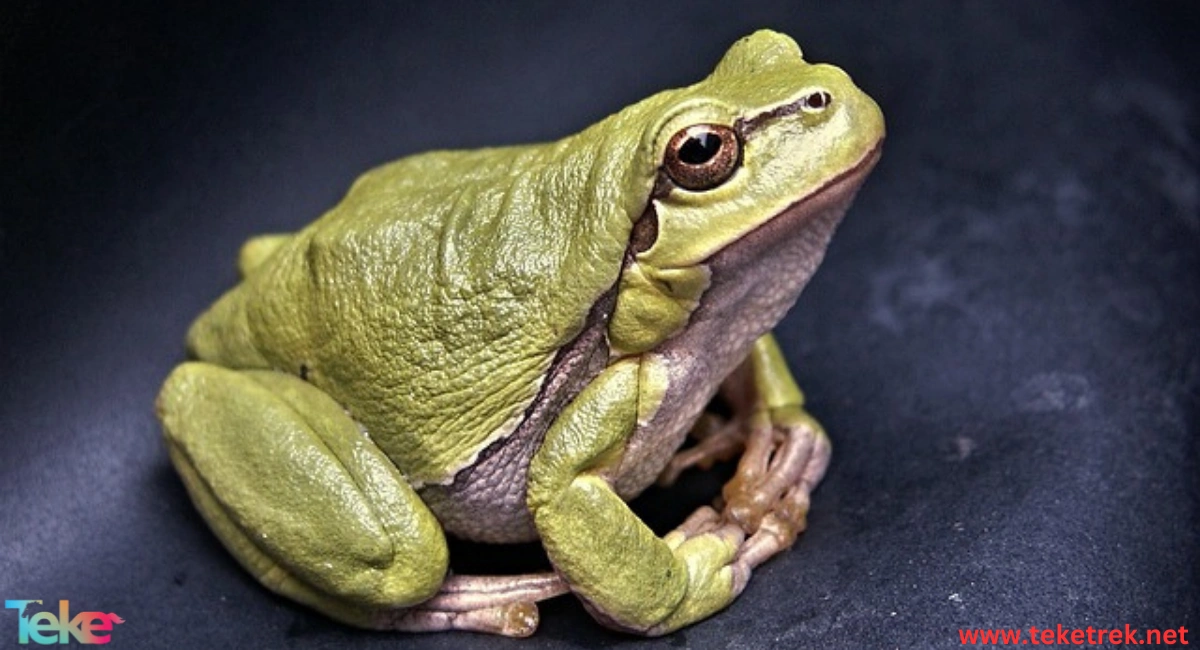The frog is an amphibious animal family of forg is the amphibian, It has bulging eyes and is characterized by its moist, porous skin and its ability to jump due to its powerful hind legs. Frogs live in most parts of the world. They feed on insects, worms, and other small organisms. Their size and color vary depending on the species, and aquatic and humid environments are considered suitable habitats for them.
Around 2,700 species of frogs have been identified. Some species spend their entire lives in water or near it, while others primarily inhabit land and only come to water for mating purposes .In this article in TekeTrek website, we’ll take a closer look at this organism, its lifestyle, diet, and some of its most important species.

How do you describe a frog?
- The frog is characterized by its stout body and its moist, porous skin. It typically has short legs in comparison to its body size, with strong hind legs that enable it to jump distinctly, and it features webbed toes.
- The color of a frog can vary between green, brown, gray, yellow, and red, often blending seamlessly with its surrounding environment for camouflage
- The frog has two large, colorful eyes that aid in hunting and guiding jumps, and it may have spots or lines on its body that also help with camouflage.
- The frog’s body is unique in that it lacks gills; it breathes through its skin. This skin absorbs oxygen and allows it to pass through.
- Frogs have three membranes on their eyes. The first two are traditional upper and lower eyelids similar to those of humans, while the third is a transparent membrane located under the lower eyelid, protecting the eye during swimming.
- The frog’s body consists of a vertebral column composed of several flexible vertebrae connected from the back by a tail bone called the coccyx.
- The size of a frog’s tail varies depending on the species; some species are tailless, while others have tails ranging from 10 to 30 mm.
- Frog skin is loose because it is not attached to the body, and the texture of the skin can be smooth or rough.
- Frogs have two external ears, but the internal auditory opening is hidden beneath the skin and appears as a rounded area on the head.
- The frog possesses small, cone-shaped teeth that are fully present in the upper jaw. Frogs do not have lower gums, and they lack lower teeth altogether.
habitat of frogs
- Frogs can be found on every continent and region of the planet, except for the Antarctic continent and extremely dry deserts.
- Most species tend to live on land near a source of freshwater.
- Poison dart frogs are found in tropical forests in Central and South America.
- The northern leopard frog inhabits northern regions of North America.
- Green-eyed tree frogs live in the rainforest areas of Queensland, Australia
the most famous frog species
- Glass Frogs: These frogs are known for their transparent or semi-transparent bodies, allowing their internal organs to be visible. They live in tropical regions of Central and South America and are considered endangered due to habitat loss and environmental degradation.
- Amazonian Pedal Frog: The smallest vertebrate in the world, this rare frog species is found in the tropical rainforests of the Amazon in Peru and Ecuador. This species is threatened with extinction due to habitat loss and environmental degradation.
- Desert Rain Frog: A rare frog species found only along the coastal strip, reaching up to 6.2 miles wide.
- Horned Frog: Known for its voracious appetite, this frog appears insatiable. It has strong feeding habits and can quickly swallow its prey. It is about six and a half inches long and features horn-like projections on its head, suitable for camouflage among leaves and branches.
What do frogs eat?
- The diet of frogs consists of a wide range of living organisms such as insects, spiders, other arthropods, worms, and mollusks.
- Frog tadpoles feed on plants in the early stages of their lives, then gradually transition to consuming meat only.
- Frogs lack teeth in their mouths, so they cannot chew; instead, they swallow their prey whole.
- Methods of catching prey vary among frogs, with many waiting for the prey to pass nearby, while others set traps for their prey.
Frog Reproduction
- Frog reproduction occurs through external fertilization of frog eggs outside the female’s body, where the female releases eggs, and the male simultaneously releases sperm.
- This is followed by a specific position called amplexus, which allows for the fertilization of all eggs.
- The male frog climbs onto the female’s back for hours or even days until the fertilization process, which depends on the number of eggs, is complete.
- Frog eggs require moisture to grow, so if some frogs lay their eggs in dry areas, they provide moisture by sprinkling them with water or urine.


more 10 facts about frogs
1. There are over 7,000 different species of frogs around the world, ranging in size from very small to quite large.
2. Some frog species have toxic poisons in their skins to defend themselves against predators.
3. Frogs shed their skin once a week. This shed skin becomes a tasty meal for other frogs.
4. Some frog species can live for over 20 years in captivity.
5. Frogs have wide-angle vision and excellent night vision.
6. The European edible frog is considered a fertile hybrid between two different frog species: the pool frog and the marsh frog.
7. Edible frogs cannot produce viable offspring with each other.
8. Frogs do not have any social organizations or true hierarchical structures. Except for a few exceptions, most of these animals hunt and sleep alone.
9. Frogs cannot regulate their internal body temperature. Instead, they need to constantly change their behavior in response to daily or seasonal fluctuations in temperature, moving into the sun or shade as needed.
10. Frogs have highly sensitive skin to chemicals and hazardous pollutants that seep into the environment.
Frequently Asked Questions about Frogs
- Is the frog poisonous or not?
Although the green and black poison dart frog is not the most toxic frog, it is still highly poisonous. A very small amount of its poison is enough to stop human heartbeats.
- What country do most frogs live?
Brazil
Colombia
Ecuador
Peru
- Family of frog،?
Class: Amphibia
Order: Anura
Family: Ranidae
Genus: Rana
- Why are frogs famous?
Frogs play a variety of roles in culture, appearing in folklore and fairy tales such as the Brothers Grimm story of The Frog Prince. In ancient Egypt and Mesopotamia, frogs symbolized fertility, while in classical antiquity, the Greeks and Romans associated frogs with fertility, harmony, and licentiousness
At the end of our article, it’s important to highlight the significant role of frogs in maintaining ecological balance and enhancing biodiversity, as frogs are considered one of the small creatures that sustain the sustainability of the ecosystem.






